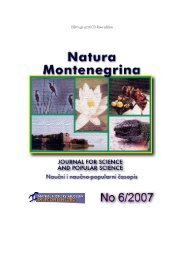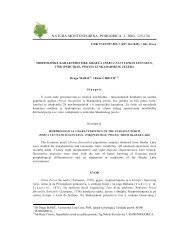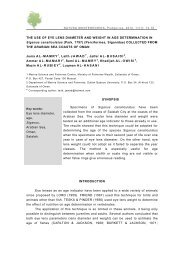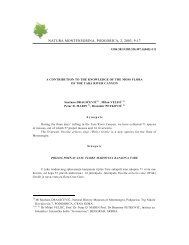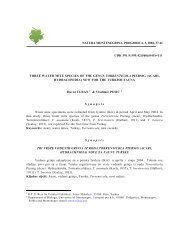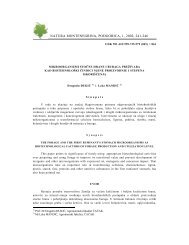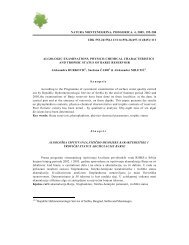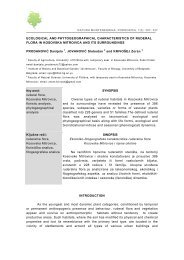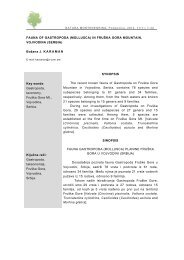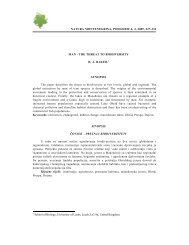MORPHOLOGICAL TRAITS OF COMMON TOAD Bufo bufo ...
MORPHOLOGICAL TRAITS OF COMMON TOAD Bufo bufo ...
MORPHOLOGICAL TRAITS OF COMMON TOAD Bufo bufo ...
Create successful ePaper yourself
Turn your PDF publications into a flip-book with our unique Google optimized e-Paper software.
107<br />
Čađenović & Vukov: <strong>MORPHOLOGICAL</strong> <strong>TRAITS</strong> <strong>OF</strong> <strong>COMMON</strong> <strong>TOAD</strong> BUFO BUFO . . .<br />
and fecundiy, favorises several values for body length of females. Greater eggs<br />
production on the other hand is explained by larger internal space for their storage,<br />
which larger females have (A n d e r s o n , 1994).<br />
The direction and magnitude of dimorphism in body length depend of various<br />
selective pressures the specimens of male and female sex are exposed to. D a r w i n<br />
(1871) assumed that sexual selection (though the competition among the specimens<br />
of the same sex or through an active selection of partner), may lead to sexual<br />
dimorphism. For instance, in species with pointed struggles among the males, males<br />
are frequently bigger than females.<br />
However, it is important to underline that common toad is one of rare secies in<br />
which males are a smaller sex, although there are struggles for females among them<br />
(H a l l i d a y and V e r r e l l , 1986; A r a k , 1988).<br />
Qualitative Analysis<br />
By a comparison of rerlative frequency of condition of monitored qualitative traits<br />
it has been noted that the same conditions, as a rule, have the greatest frequency<br />
both in the sample of males and in the sample of females (Tabele 3). The exception is<br />
the convexity of of warts in head region (in males the largest relative frequency have<br />
the warts which are indented, and with females warts are very protuberant) and the<br />
appearance of thornlike endings of ventral side of head region (most frequently weakly<br />
expressed in males and averagely expressed in females). The table of relative<br />
frequency of the conditions indicates that with females the variability of condition is<br />
higher than with males.<br />
By a correspondant analysis we have monitored the impact of qualitative traits<br />
on ordination of specimens of both sexes. The first corresponding axis has separated<br />
24.69% of variability, and the other one 17.03%. There is no clear sex separation<br />
(Figure 1). The sample of males indicates an uniformity in respect of monitored traits.<br />
Only one male has been separated during the second coresponding axis from the<br />
„main cloud” of male specimens on basis of two traits (11b and 12b) (Figure 2). One<br />
may observe a higher variability in scope of the sample of females. Traits 1c, 4b and<br />
5a separate two females along the first correspoding axis from other females, where it<br />
should be mentioned that these two traits as well as the traits 2a, 3b and 6b influence<br />
separating of females from males (Figures 1 and 2).<br />
The significance of this paper is in presenting for the first time the analysis of a<br />
larger number of morphometric and qualitative characters of population of the species<br />
<strong>Bufo</strong> <strong>bufo</strong> from Biogradsko Lake. These data make the grounds for further<br />
investigations of the populations of the species <strong>Bufo</strong> <strong>bufo</strong> both from Biogradsko Lake<br />
and the populations of this species from the territory of entire ontenegro.



